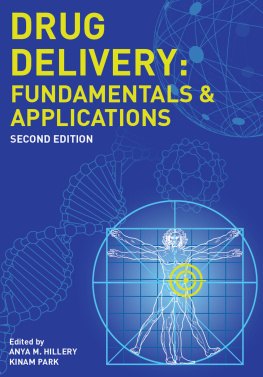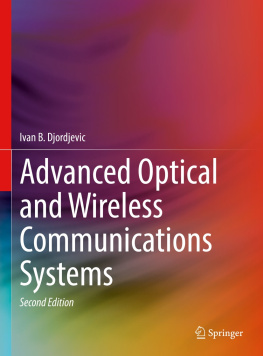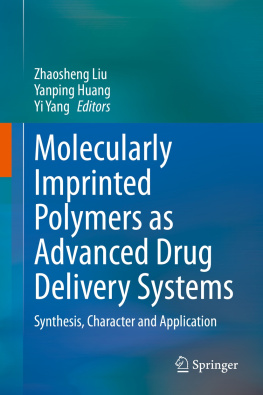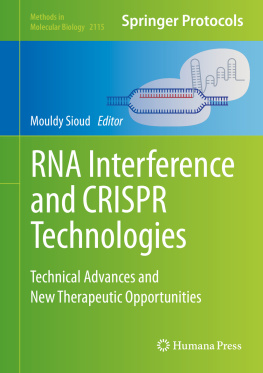Contents
Page List
Guide

DRUG DELIVERY: FUNDAMENTALS & APPLICATIONS
SECOND EDITION
DRUG DELIVERY: FUNDAMENTALS & APPLICATIONS
SECOND EDITION
Edited by
Anya M. Hillery
Saint Louis University - Madrid Campus, Madrid, Spain
Kinam Park
Purdue University, West Lafayette, IN, USA

CRC Press
Taylor & Francis Group
6000 Broken Sound Parkway NW, Suite 300
Boca Raton, FL 33487-2742
2017 by Taylor & Francis Group, LLC
CRC Press is an imprint of Taylor & Francis Group, an Informa business
No claim to original U.S. Government works
Printed on acid-free paper
Version Date: 20160603
International Standard Book Number-13: 978-1-4822-1771-1 (Paperback)
This book contains information obtained from authentic and highly regarded sources. Reasonable efforts have been made to publish reliable data and information, but the author and publisher cannot assume responsibility for the validity of all materials or the consequences of their use. The authors and publishers have attempted to trace the copyright holders of all material reproduced in this publication and apologize to copyright holders if permission to publish in this form has not been obtained. If any copyright material has not been acknowledged please write and let us know so we may rectify in any future reprint.
Except as permitted under U.S. Copyright Law, no part of this book may be reprinted, reproduced, transmitted, or utilized in any form by any electronic, mechanical, or other means, now known or hereafter invented, including photocopying, microfilming, and recording, or in any information storage or retrieval system, without written permission from the publishers.
For permission to photocopy or use material electronically from this work, please access www.copyright.com (http://www.copyright.com/) or contact the Copyright Clearance Center, Inc. (CCC), 222 Rosewood Drive, Danvers, MA 01923, 978-750-8400. CCC is a not-for-profit organization that provides licenses and registration for a variety of users. For organizations that have been granted a photocopy license by the CCC, a separate system of payment has been arranged.
Trademark Notice: Product or corporate names may be trademarks or registered trademarks, and are used only for identification and explanation without intent to infringe.
Visit the Taylor & Francis Web site at
http://www.taylorandfrancis.com
and the CRC Press Web site at
http://www.crcpress.com
Contents
Anya M. Hillery and Allan S. Hoffman
Yvonne Perrie, Thomas Rades, and Kirsten Graeser
Kohsaku Kawakami and Anya M. Hillery
Floriane Laurent, Anya M. Hillery, and Randall Mrsny
Alexander T. Florence and Daan J.A. Crommelin
Jeremy C. Wright and James Matriano
Anya M. Hillery and David J. Brayden
Marc B. Brown and Viralkumar F. Patel
Simon R. Corrie and Mark A.F. Kendall
Per Gisle Djupesland and Anya M. Hillery
Heidi M. Mansour, Paul B. Myrdal, Usir Younis, Priya Muralidharan, Anya M. Hillery, and Don Hayes, Jr.
Patrick F. Kiser, Justin T. Clark, and Jonathan T. Su
Clive G. Wilson, Mariam Badawi, Anya M. Hillery, Shyamanga Borooah, Roly Megaw, and Baljean Dhillon
Ronald A. Siegel and Carmen Alvarez-Lorenzo
Anya M. Hillery
Kwang Suk Lim and Sung Wan Kim
Terry L. Bowersock and Suman M. Mahan
Anthony S. Malamas and Zheng-Rong Lu
Erica Schlesinger, Cade Fox, and Tejal Desai
Haizhen A. Zhong, Osman F. Gner, and J. Phillip Bowen
Donna Cabral-Lilly and Lawrence D. Mayer
Louise Rosenmayr-Templeton
David Needham
Anya M. Hillery and Kinam Park
Controlled drug delivery systems have evolved over the past six decades, from the sustained-release Spansule technology of the 1950s to the highly sophisticated and targeted drug delivery systems of today. Numerous drug delivery systems (DDS) have been successfully developed for clinical applications over the years, and the demand for innovative technologies continues to grow, driving a variety of new developments in the field. This book describes the fundamental concepts and underlying scientific principles of drug delivery, current applications of drug delivery technologies, and potential future developments in the field. It is intended to serve both as a core textbook and as a valuable reference source for students, researchers, practitioners, and scientists in disciplines including the pharmaceutical and formulation sciences, chemical and biomedical engineering, materials science, medicine and oncology, the health sciences, and natural sciences.
In common with the first edition, opens with a historical introduction to the field of controlled drug delivery to provide relevant background details for the subsequent chapters.
Section I: Fundamental Issues serves as a comprehensive introduction to the fundamental concepts that underpin drug delivery and targeting. ) is dedicated to providing a comprehensive overview of the characteristics and properties of the various types of epithelial interfaces in the body of relevance for drug delivery strategies; the factors that influence drug transport across these interfaces are also described.
Section II: Parenteral Routes for Drug Delivery and Targeting opens with a chapter on nano-technology, the engineering and manufacturing of materials at the molecular scale, which offers the potential to revolutionize the drug delivery field..
Section III: Nonparenteral Routes for Drug Delivery and Targeting describes the major epithelial routes of drug delivery currently under investigation. In keeping with the objective to emphasize an understanding of the biological obstacles for successful drug delivery, each chapter of this section begins with a detailed consideration of the relevant anatomical and physiological barriers pertaining specifically to the route in question, as well as the implications therein to successful drug delivery and targeting via this route. The first epithelial route described is the oral route (), the most common and convenient of the existing administration methods for introducing drugs to the bloodstream. The oral route is discussed with respect to the various mechanisms of controlled release, regional targeting, strategies for improving bioavailability, and the use of vaccines. These same themes recur through the following chapters on the various other epithelial routes, many of which also serve as alternative portals of drug entry to the systemic circulation. The chapters in Section III deliberately follow a common format, in order to ease understanding and facilitate learning, and also to highlight the many similarities that exist between the various epithelial routes, as well as the unique attributes associated with each specific route.
Section IV: Emerging Technologies covers some of the new and exciting possibilities that are emerging as future directions in the field. describes the leverage of techniques from the microelectronics industry to precisely fabricate DDS in the nanometer range and the application of such nanofabricated systems to drug delivery.
Section V: Toward Commercialization is an entirely new section for this edition, which reflects the onward success and progress of drug delivery in the 15 years since the publication of the first edition, as technology moves from bench to bedside. presents an engaging account of the clinical translation of a liposomal product (ThermoDox, a thermal-sensitive liposome for cancer therapy). It provides an illuminating insight, from the inventors perspective, into the processand difficultiesof guiding a DDS through initial funding, development, and preclinical and clinical trials.










